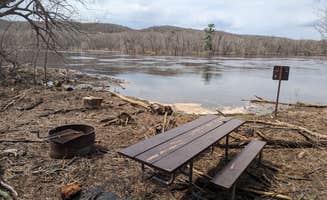Primitive camping near Minneapolis, Minnesota offers camping opportunities on public lands with minimal or no facilities. South of Sand Dunes State Forest features numerous pull-off sites along gravel roads where vehicles can access small clearings within pine and oak woodland. These sites accommodate tent campers and small vehicles approximately 45 minutes from the Minneapolis metro area, creating accessible wilderness experiences for city residents seeking nearby nature immersion.
What to do
Birding experiences: Sandy areas and pine forests at South of Sand Dunes State Forest support diverse bird populations. "Quiet with lots of different bird sounds," notes Jason B., who observed various species during his stay. Bird activity peaks during early morning hours when forest traffic remains minimal.
Wildlife photography: Evening and early morning provide optimal wildlife viewing opportunities. Heather W. cautions about certain residents: "Stand storks are very protective. Stay away from them. They attack." Bringing telephoto lenses allows safe documentation of these territorial birds.
Hammock camping: The forest environment creates ideal hammock suspension points between trees. "I was able to walk in and find an incredible spot to camp and lay in my hammock," reports Joslyn H., highlighting the accessibility of comfortable hanging spots throughout the forest.
Trail exploration: The Ice Age Trail passes through Sandy Cove on the St. Croix River, offering hikers connection to longer routes. "Well managed gravel trail to the south and single wide footpath to the north," describes Travis B., noting the dual trail options available to campers at this location.
What campers like
Proximity to Minneapolis: The short driving distance from urban areas makes these sites practical for quick getaways. Samuel C. confirms, "For the proximity to the city and nearby highways, this was a good spot." Most primitive sites lie within 60 minutes of downtown Minneapolis.
Vehicle accessibility: Despite rustic settings, most dispersed sites feature reasonable access roads. "I stayed here for one night and roads were totally fine for any vehicle," reports Samuel C., though he notes that big rigs would find limited suitable spots in the area.
Weekday solitude: Visitor patterns show significantly reduced traffic midweek. "After 12 p.m., not much of anything," notes Skip H. about his return visit, suggesting late arrivals on weekdays encounter fewer fellow campers and vehicles.
Riverside settings: St. Croix River locations provide water access and scenic views. "Right on the beautiful St. Croix river," Travis B. notes about Sandy Cove, highlighting the direct water frontage that attracts paddlers and those seeking riparian camping experiences.
What you should know
Road traffic concerns: Forest roads see regular vehicle traffic that affects camp tranquility. Ryan P. warns, "This road is pretty busy for a dirt forest road and people FLY down it. Almost got hit a few times walking." Safety precautions include selecting sites set back from main routes.
Seasonal flooding risks: Riverside locations experience significant water level fluctuations. Travis B. describes Sandy Cove during spring: "We visited in April after historic snowfall and thaw causing the river to flood." Spring campers should check water levels before trips.
Accessibility limitations: Many sites require some walking from parking areas. "Drive until a decay path opens, park, then trek 100–300 ft off-road to your camp," advises Alison O., indicating the typical distances between vehicle parking and optimal tent placement at South of Sand Dunes State Forest.
Cell service reliability: Communication technology functions inconsistently throughout these areas. "Weak cell service but manageable," notes one camper quoted by Alison O., suggesting visitors download maps and essential information before arrival.
Tips for camping with families
Road safety education: Children require clear guidance about forest road hazards. Ryan P.'s observation that "Even through a Wednesday night cars are flying down the road" underscores the importance of establishing firm boundaries about road proximity.
Site selection criteria: Families benefit from selecting sites with natural boundaries. Gregory observed that "most sites were shaded," providing natural UV protection during summer months when exploring with children.
Wildlife encounters: Local wildlife provides educational opportunities with proper preparation. Heather W.'s encounter with territorial "Stand storks" indicates the importance of teaching children about respectful wildlife observation distances.
Insect management: Mosquito populations affect comfort levels significantly. "After 5mins of the door being opened and several flying in, we decided the area wasn't for us," relates Gregory, highlighting the need for comprehensive insect protection strategies with children.
Tips from RVers
Size limitations: Larger recreational vehicles face significant space constraints at primitive sites. "Best for straight vehicles or very small trailers," advises Skip H. about South of Sand Dunes, indicating that truck campers and vans suit these areas better than conventional travel trailers or motorhomes.
Overhead clearance issues: Tree canopies restrict access for taller vehicles. Gregory notes, "We did find one we thought we liked, but branches over hung, and rested on our camper (8ft high)," revealing potential damage risks for standard-height RVs.
Regulatory awareness: Local enforcement affects RV camping experiences. Jason B. recounts, "I had a county sheriff person tell me it's not lawful to park a trailer and they kicked me out. I called the DNR and they said that wasn't right," suggesting inconsistent interpretation of regulations between agencies that impact RV campers.



